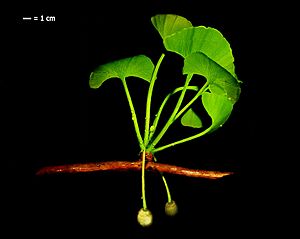Ginkgo cranei facts for kids
Quick facts for kids Ginkgo cranei |
|
|---|---|
 |
|
| Reconstruction of Ginkgo cranei by B.M. Begović Bego and Z. Zhou, 2012 | |
| Scientific classification | |
| Genus: |
Ginkgo
|
| Species: |
cranei
|
Ginkgo cranei was an ancient type of Ginkgo tree. It is now extinct, meaning it no longer lives on Earth. Scientists learned about it from fossil parts like its leaves and special seed-producing structures. These fossils were found in North Dakota, USA. Ginkgo cranei is special because it's the first Ginkgo fossil from the Paleogene period that includes these seed structures.
Contents
Discovering Ginkgo cranei
The fossils of Ginkgo cranei were found in North Dakota, USA. They came from a rock layer called the Sentinel Butte Formation. This area is near the town of Almont, North Dakota.
The fossils were preserved in a type of rock called shale. This shale is yellow or brown and has a lot of iron. What's cool is that many of these fossils kept their original 3D shape. This means we can see details of the stems and seed structures.
Scientists figured out the age of these rocks by looking at other fossils found there. These included ancient mammals and tiny plant parts like pollen. The rocks are from the Late Paleocene time period.
Fossil Specimens
Scientists found seven special seed-producing structures of G. cranei. These are called "ovulate organs." Some of these fossils are kept at the University of Wisconsin–Stevens Point. Others are at the Field Museum of Natural History in Chicago, Illinois.
The main fossil used to describe the species is called the "holotype." It's like the official example. Another important fossil is called the "paratype."
Fossil leaves were also found with these seed structures. Before, these leaves were thought to belong to a different ancient Ginkgo species, Ginkgo adiantoides.
Naming the Species
Three paleobotanists (scientists who study ancient plants) studied these fossils. They were Zhiyan Zhou, Cheng Quan, and Yu-Sheng (Christopher) Liu. They published their findings in 2012.
They named the species cranei to honor Sir Peter Crane. He was one of the scientists who first discovered the Ginkgo fossils in Almont. He found them with Steven Manchester and David Dilcher.
What Ginkgo cranei Looked Like
The seed-producing structures of G. cranei were unique. They had special cells on their surface that were thick and dome-shaped. These structures were about 10 to 19 millimeters long and 12 to 17 millimeters wide.
Comparing to Modern Ginkgo
The Ginkgo biloba is the only Ginkgo species alive today. Its seed structures are larger than G. cranei's. They are about 30 by 20 millimeters. Also, the cells on their surface are not as bulging.
G. cranei also had fewer "stomata" on its seed structures and leaves. Stomata are tiny pores that plants use to breathe. Ginkgo biloba has more of these pores. These differences help scientists tell the ancient Ginkgo cranei apart from the modern Ginkgo biloba.

